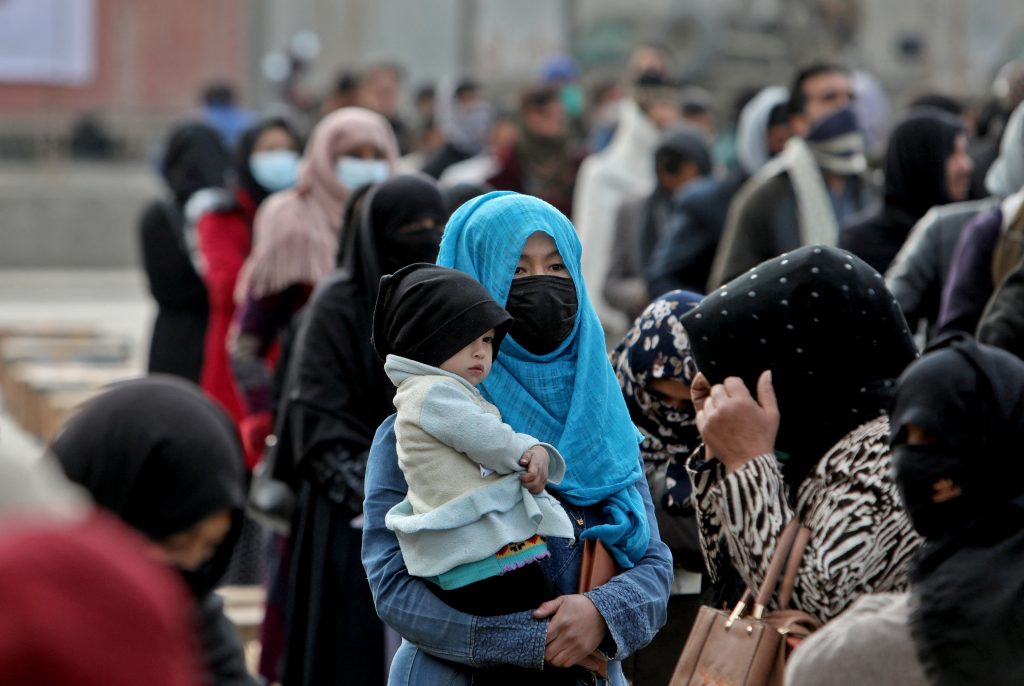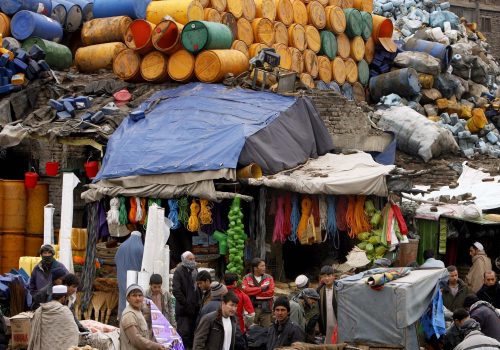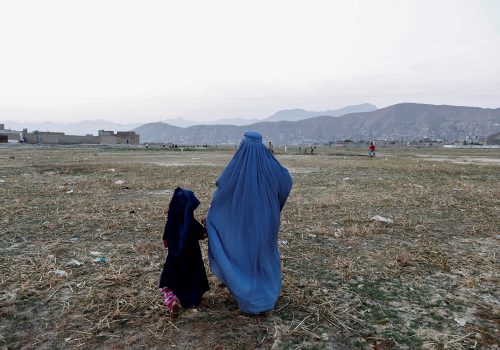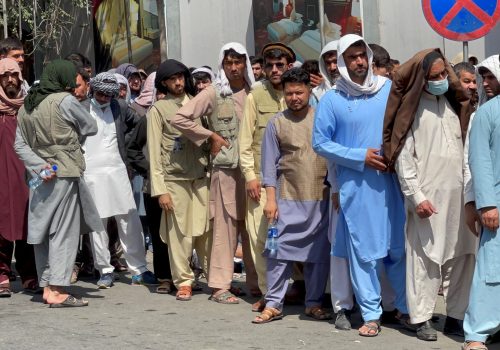Amid the horrors unfolding in Ukraine and the refugees fleeing to surrounding nations, the prime focus of the United States and European nations is rightly on Eastern Europe. But the humanitarian catastrophe in Afghanistan continues, and efforts thus far to stem the worst outcomes remain insufficient. Crises are not resolved just because the headlines change.
Like in other parts of the world where geopolitical and counterterrorism challenges have massive repercussions for international finance—think Russia, Yemen, and Syria—the most basic of human needs in Afghanistan have been drowned in regulation, liability, and process. Aid organizations, advocacy groups, and generations of experts who built their careers in the country rightfully believe that their governments have not consolidated their efforts to address the situation at hand; without immediate assistance, much of the country risks famine. At an international pledging conference on March 31, forty-one countries—including the United States, United Kingdom, and Germany—vowed to collectively chip in $2.44 billion in support of the humanitarian response in Afghanistan, a substantial sum though well short of the United Nations (UN) appeal for $4.4 billion. The biggest question now is how will that money get to the people who need it most?
There has been some progress toward resolving this critical question. On February 11, the Biden administration began to dislodge a complicated web of overlapping legal and financial roadblocks that had prevented US-held Afghan assets, foreign aid, and commercial trade from humanitarian use or as liquidity for domestic markets. Citing the International Emergency Economic Powers Act, the administration divided the seven billion dollars in reserves—half to be preserved in the United States potentially for victims of the 9/11 attacks* subject to further litigation, per a longstanding court case, and half for distribution to Afghans as humanitarian or financial assistance. Then on February 25, the administration issued General License 20 authorizing transactions with Afghanistan and its governing institutions, hoping to eliminate some of the uncertainty surrounding finance in the country.
While some restrictions have been eased, US sanctions, which designate the Taliban as a “Specially Designated Global Terrorist,”* are here to stay, and they turn any proposed transaction with Afghanistan into a byzantine regulatory adventure. This is done with good intention—counterterrorism—but at the expense of the Afghan people. A measles outbreak that is causing “irreparable damage” to Afghan children and a severe shortage of medicine is exacerbating the health crisis in the country. Afghans are also facing a food insecurity and malnutrition crisis of “unparalleled proportions,” with 95 percent of all Afghans not having enough to eat, amid a surge in food and fuel prices as a result of the war in Ukraine.
Now that at least $3.5 billion in assets have been legally obligated for use or distribution, the Organization of Islamic Cooperation nations have pledged to set up a humanitarian trust fund for Afghanistan, and the UN conference netted another $2.44 billion in pledges, it is time to consider financial tools that can effectively deliver these and other funds to Afghanistan in a high-risk, heavily sanctioned environment. This requires some creative thinking.
We propose four ways for the United States and its allies to use alternative means of providing liquidity to Afghanistan. Inspired by an off-the-record conversation among financial, regulatory, non-profit, and diplomatic experts hosted by the Atlantic Council’s Economic Statecraft Initiative and South Asia Center, these are options that would take minimal time to activate and could remain operational as postwar Afghanistan policy matures:
1. Internationalize a risk framework
What this means: An international framework could clarify for diverse actors the scope of activities that are permitted in Afghanistan, the due diligence that must be exercised in order to mitigate the risk that resources fall into the wrong hands, and the various legal and regulatory details relevant for the movement of funds into and within Afghanistan.
After decades of counter-Taliban measures and US policy U-turns (such as on Iran), financial institutions are justified in questioning the scope of permissible financial activities. Worse still, with no clear prospect of profit, most financial actors have chosen to forego that risk entirely, resulting in Afghanistan being de-risked and international transactions halting. Nongovernmental organizations (NGOs) also report that each of their donors has a different tolerance level for the risks that doing business in Afghanistan might entail, as well as a varied understanding of how sanctions work.
How it would work: Outside of the government, aid agencies, NGOs, and international financial institutions would negotiate a set of risk thresholds for navigating Taliban-related sanctions and financial crime such as the drug trade. At the same time inside government, officials must understand that while they have been generous when compared to other sanctions programs in issuing licenses to operate in Afghanistan, press releases do not stand on their own. US and European officials (particularly in the United Kingdom and Germany, where the lion’s share of hard currency transactions are cleared) must further explain the full scope of licensing and enforcement posture and provide models for a successful transaction.
Historical precedent: Stakeholders can follow models developed for Syria, one of the most sanctioned countries in the world, and other high-risk jurisdictions where Western governments do not recognize a country’s or territory’s leadership. This includes Gaza or Yemen, where the Biden administration licensed commercial transactions while reviewing the impact of economic restrictions. Prior to the Taliban’s takeover of Kabul, aid agencies, NGOs, and financial institutions in Afghanistan had an implicit understanding of the risk management required to ensure that funds were not accessed by sanctioned entities and individuals. There is room for Western governments to coordinate with humanitarian and financial actors to expand on this precedent and align their understanding of acceptable risks.
2. Set up special purpose vehicles
What this means: A special purpose vehicle (SPV) is a tailor-made financial tool that typically allows financial institutions to firewall their central balance sheets and shield importers and exporters from a specific set of risks. In the case of Afghanistan, an SPV would focus exclusively on reducing the risk involved in conducting humanitarian trade and could remain operational indefinitely if sufficient liquidity remains in the pipeline. With a semi-permanent trading house or clearing mechanism working as an intermediary between foreign companies and Afghan importers, import-export businesses could function independently of specific allocations of money from NGOs or governments, which are subject to disbursement delays or legislative fights over appropriations.
How it would work: An SPV model would finance deliveries of humanitarian goods through indirect payments involving only non-sanctioned banks and trading entities. Intermediaries would conduct enhanced due diligence and implement anti-money laundering controls to ensure each transaction is not linked to sanctioned stakeholders and is logged on a trade ledger. The SPV could operate independently or within a major financial institution and be scaled as required. Such a model would require an initial injection of several million dollars in liquidity to underwrite the initial trades from government, venture capital, or nonprofit resources and to be operational within weeks.
Historical precedent: Financial institutions often use SPVs and other off-sheet transactions to stem prudential risks. For example, in the national-security context, the United Kingdom, France, and Germany made efforts to finance humanitarian trade with Iran when firms and banks withdrew due to secondary sanctions, even though humanitarian trade is not sanctionable under US law. For Afghanistan, an SPV would ideally not be linked to specific political deliverables, such as the survival of the Iran nuclear deal, and not linked to any government.
3. Consider correspondent banking through a third party
What this means: The United States could make currency swaps with third-party country banks to provide Afghanistan access to hard currency. These arrangements, called correspondent banking, are the lifeblood of the international financial system, particularly for smaller countries with a soft or fluctuating currency. Access to dollars and other major currencies is critical for customer payments, stabilizing the cash supply, and processing cross-border transactions. International banks that provided correspondent banking services to Afghanistan have dropped their relationships with partners in the country to avoid running afoul of sanctions. Now that Afghanistan has been swiftly de-risked and international transactions have halted—even with the recent US authorization of transactions with Afghanistan’s governing institutions through General License 20—Western banks are unlikely to re-engage in the short-term. To fulfil the intention of the license, governments should explore processing cross-border payments through a regional intermediary.
How it would work: A third country with regional access and a developed banking sector could use its relationships with Western financial institutions to serve as a bridge between local banks or as remittance providers within Afghanistan to inject liquidity into domestic markets. Akin to “embassy banking,” this model would allow official representatives of high-risk jurisdictions to maintain limited banking access. These intermediaries could assist in establishing an SPV model as well as in the distribution of privately held assets currently frozen abroad. Additionally, regulators overseeing major currencies of settlement, such as the dollar, euro, and pound, could establish standards—an informal consortium—for clearing transactions from Afghanistan, now a high-risk jurisdiction.
Historical precedent: Here too Yemen provides precedent. After the Financial Action Task Force labeled Yemen a high-risk jurisdiction in 2015, several banks in Western Europe and Canada closed their correspondent accounts for Yemeni banks and ended relationships with Yemeni businesses. Nevertheless, Lebanese banks like the Bank of Beirut continued to be middlemen, financing and facilitating international trade with Yemen. Banks in Bahrain, China, Jordan, Kuwait, and Qatar, among others, continue providing correspondent banking services to Yemen. These correspondent banks were able to mobilize formal and informal financial networks to effectively provide services.
4. Harness blockchain and digital payments
What this means: Digital currency is a new but promising frontier. Blockchain technology relies on decentralized financial systems or distributed ledgers that could directly connect donors with clearing houses in Afghanistan. The blockchain can track transaction patterns and be programmed to block sanctioned transactions, an additional advantage. Using a peer-to-peer network, some versions could build in a freezing function that kicks in should funds land in the wrong hands.
How it would work: Donors put fiat money into a platform that swaps to cryptocurrency. A digital token is then created, representing the exact value and its ownership while blockchain infrastructures ensure sanctioned entities are unable to access it. Once digital tokens are transferred to the recipient entities in Afghanistan, the translation of value to the ultimate end users can be facilitated either through cash or through unhosted wallets that are controlled by individuals without the need of an intermediary. But there’s a possible hurdle: The ultimate beneficiaries must have access to the relevant technology; otherwise a digital currency would hold little value as a means of exchange. However, digital currencies have a surprisingly high penetration rate in Afghanistan, a likely symptom of a population that has been routinely underserviced by the formal financial sector. The requisite platforms and underlying technology for a blockchain solution are under development and could be deployed rapidly in Afghanistan.
Historical precedent: Blockchain technologies are relatively new to humanitarian assistance and to providing broad-based liquidity. A blockchain option for Afghanistan would be among the first of its kind. Nevertheless, the World Food Program’s Building Blocks project has shown encouraging signs for what can be achieved. Since 2017, the project has scaled to provide $325 million total in transfers through cryptocurrency to Bangladesh and Jordan and serves one million refugees every month. Blockchain technology itself has become instrumental in tracing money laundering and cyber criminality, such as the Colonial Pipeline hack last year.
Maintaining the momentum
These options are not silver bullets; they don’t promise a seamless transition to a healthy Afghan economy. But they are a start. Given the severity of the humanitarian crisis, alternative ways of managing risk and means of payment can offer a semi-permanent path out of the financial sector liquidity trap while governments, NGOs, and international financial institutions hammer out their policies for post-war Afghanistan.
This week’s donor conference was a positive step, but pledging money is only the first step. Getting it to its intended recipients and into the real economy is the hard part.
Julia Friedlander is the director of the Economic Statecraft Initiative at the Atlantic Council. She previously served as senior advisor at the US Treasury Department’s Office of Terrorism and Financial Intelligence and on the National Security Council from 2017 to 2019.
Mrugank Bhusari is a program assistant at the Atlantic Council’s GeoEconomics Center focusing on international finance and human security.
Correction: A previous version of this piece inaccurately stated that half of the seized Afghan funds were already going to 9/11 victims (litigation is ongoing in that case) and gave an incorrect name for the Taliban’s US sanctions designation. The group is formally classified as a Specially Designated Global Terrorist, not a Foreign Terrorist Organization.
Further reading
Mon, Mar 28, 2022
For Afghanistan’s economic revival, focus on macroeconomic stability, financial flows, and economic governance
SouthAsiaSource By
The Biden administration’s General License, announced in February 2022 and exempting international commercial transactions from US sanctions, is a step in the right direction, but its effects will prove limited.
Wed, Mar 2, 2022
The United States must help Afghan women and girls—even if it requires partnership with China
New Atlanticist By
It’s time for the Biden administration to look beyond its competition with China and realize that sometimes cooperation makes sense, even with one’s adversaries.
Tue, Feb 15, 2022
On Afghanistan’s $7B question, Biden gets it right
New Atlanticist By Brian O’Toole
The administration has been playing kabuki to ensure at least some cash makes it to the Afghan people.
Image: An Afghan woman holds her child as she and others wait to receive package being distributed by a Turkish humanitarian aid group at a distribution center in Kabul, Afghanistan, on December 15, 2021. Photo by Ali Khara/Reuters.



